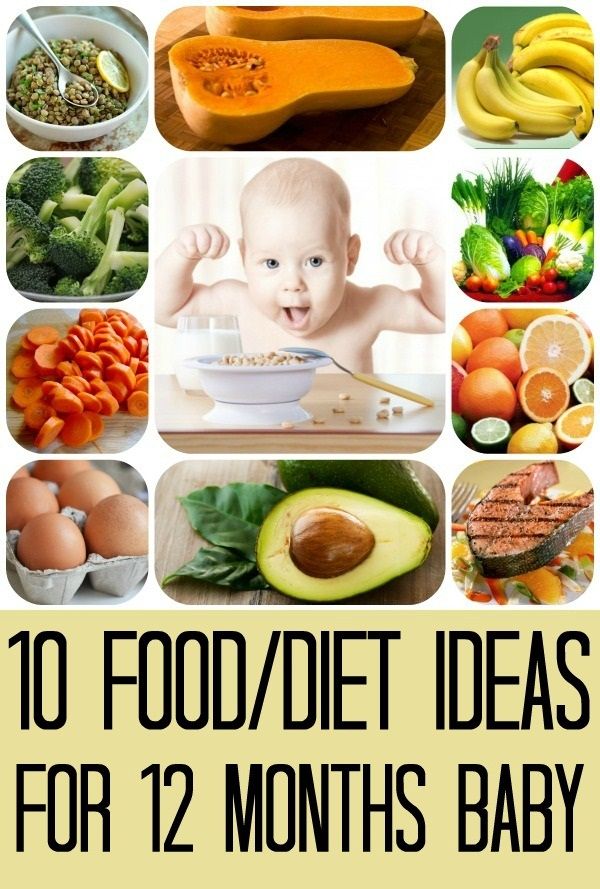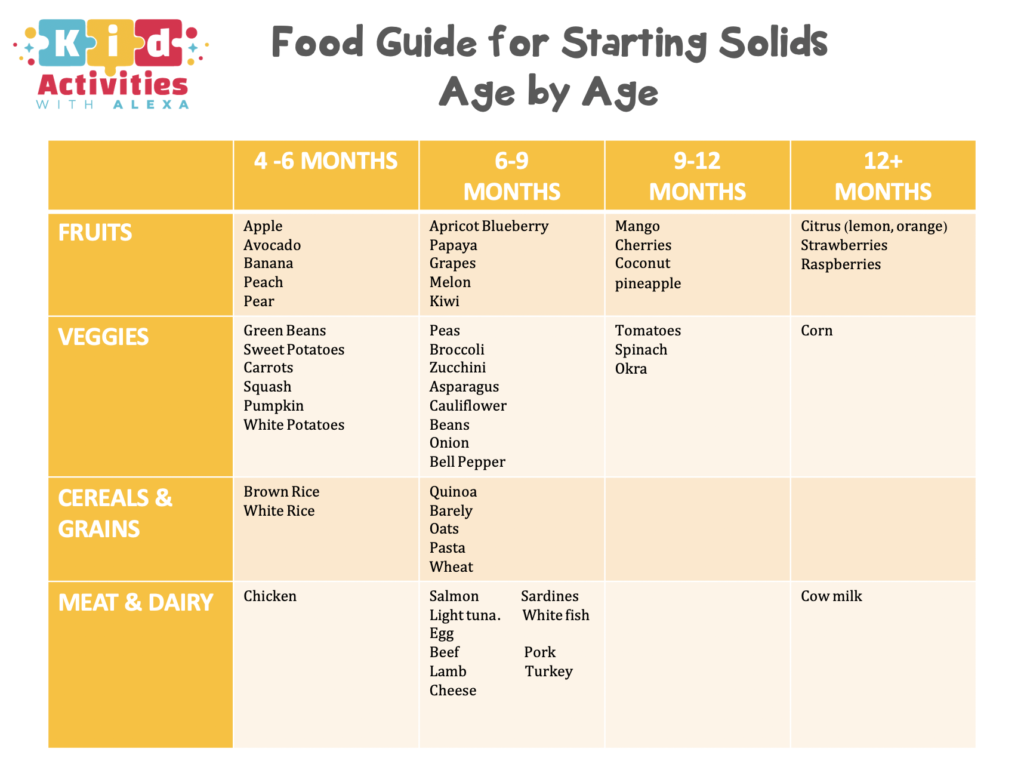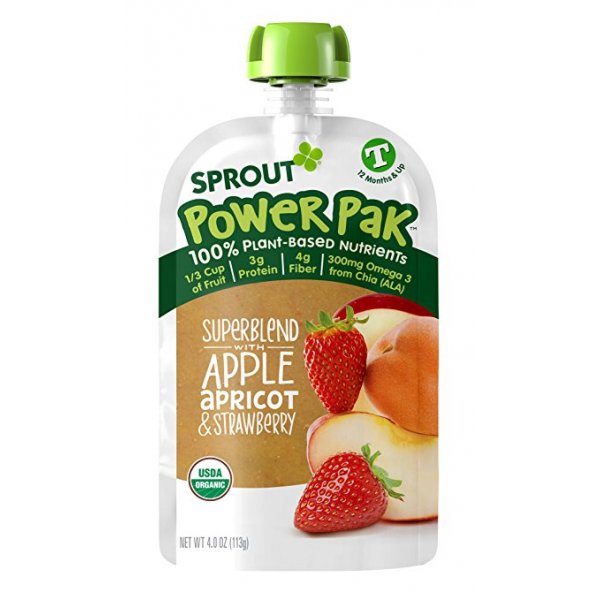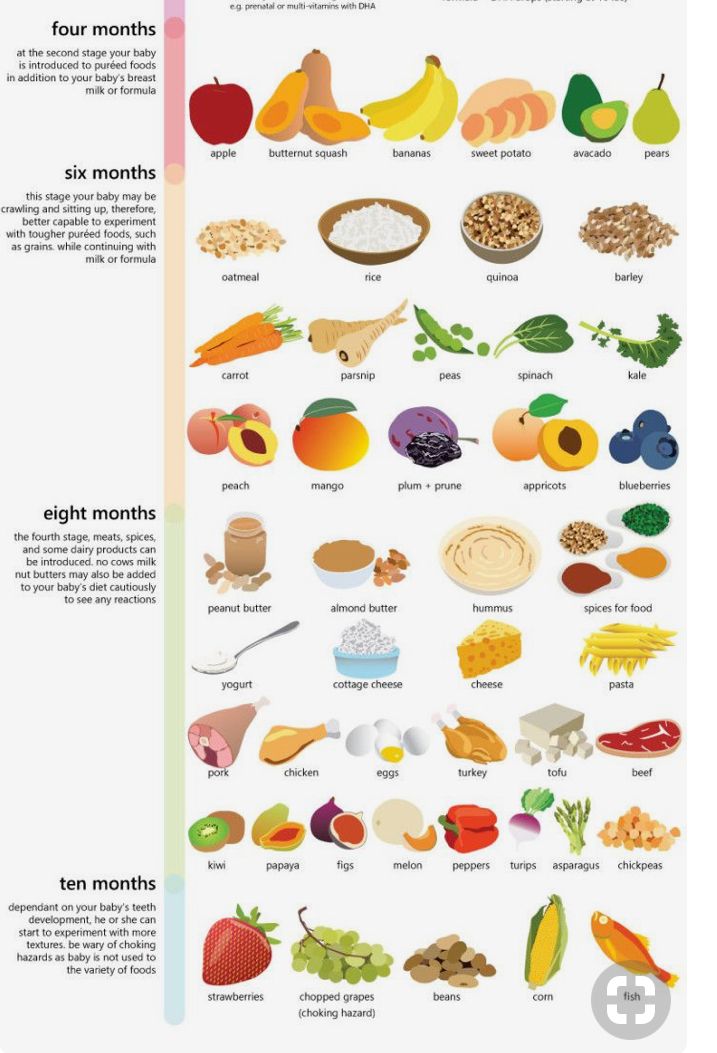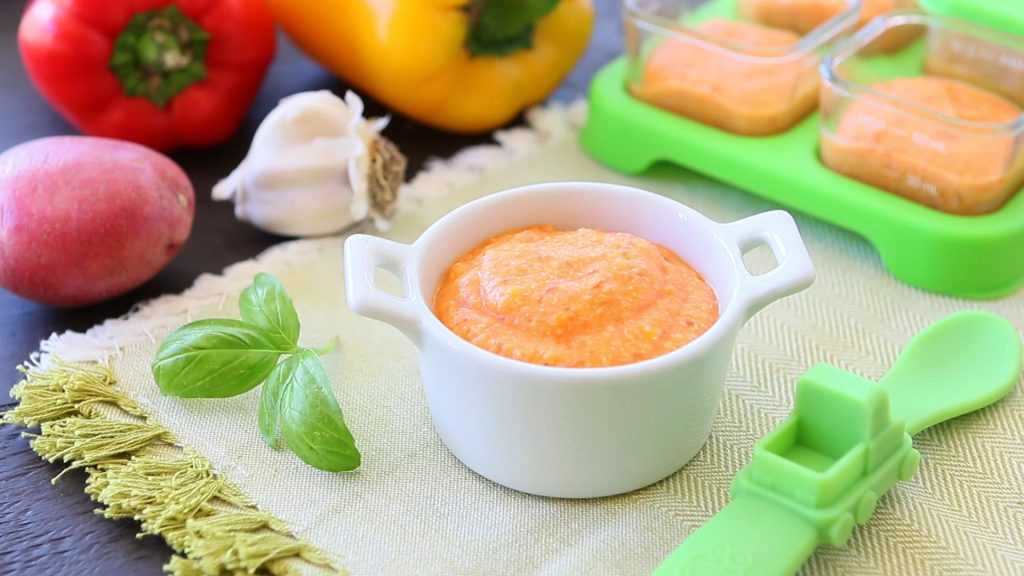Safe food for 6 month old baby
When is baby rice cereal safe for infants to eat?
Baby cereal is made with oats, barley, rice, or other grains that are ground finely. Fortified baby cereal has added iron and other vitamins and nutrients, making it a good first food for your baby. It has a number of minerals, including iron, zinc, and magnesium; and some varieties have vitamins (such as vitamins A, E, D, and B), too.
To prepare baby cereal, you can add 1 tablespoon of breast milk, formula, or water to 4 or 5 tablespoons of cereal to give it a soupy consistency; add less fluid as your baby gets the hang of eating more textured food. You can also mix baby cereal with other baby food to introduce your little one to a variety of textures and tastes.
When do babies start eating cereal?
As soon as your baby is ready to eat solid foods, they can try baby cereal. Babies are usually ready to start solids around 6 months. Signs that they're ready include having good head and neck control, being able to sit up on their own, and showing an interest in food (opening their mouth and leaning forward when it's near).
You can also mix baby cereal with other purees, like pear, squash, or prunes, to help them get used to varieties of food. This could be helpful if your baby likes the taste of cereal, but seems reluctant to try other foods. If the puree seems too thick for them, add more liquid to thin it out and make it easier to swallow.
Always feed your baby cereal with a spoon – don't add it to formula or breast milk in a bottle, since your baby could choke on it and they may end up eating more than they need.
Is baby cereal safe?
Baby cereal is safe as long as it's prepared correctly and your baby is ready for solid foods. In fact, baby cereal can be an important part of your baby's diet, since many varieties are fortified with essential nutrients.
Fortified baby cereal is an excellent source of iron, which babies need starting at around 6 months. This is especially important if your baby is breastfed, since breast milk doesn't contain very much iron. (Many formula varieties are fortified with iron.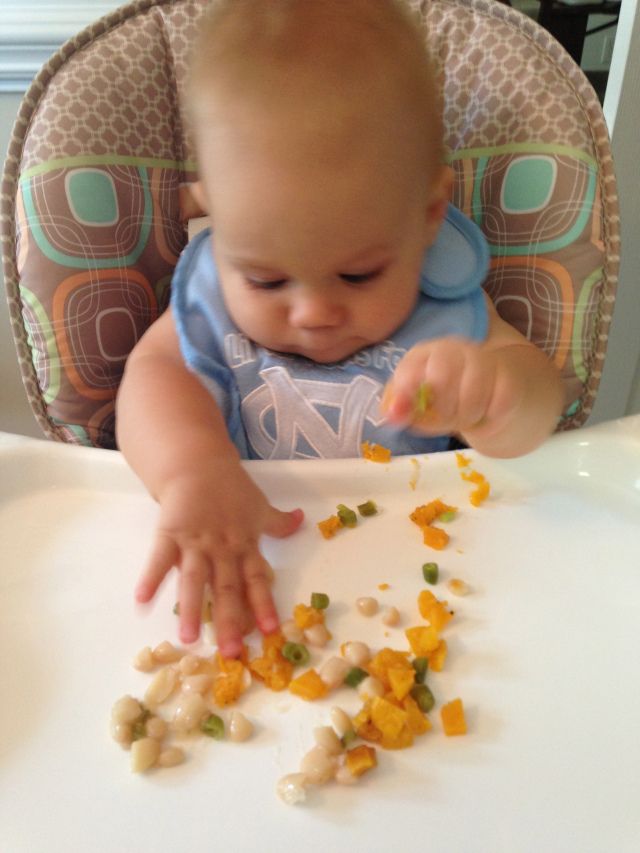 )
)
Any time you give your baby a new food, wait three to five days before adding another new food to their diet. That goes for different types of grains, too – if you start by giving your baby oat-based cereal, wait before giving your baby another type of grain, like wheat. This way, if your baby has an allergic reaction, it'll be easier to pinpoint what might have caused it.
Signs of a food allergy include hives, itchy skin rashes, swelling, nausea, vomiting, diarrhea, wheezing/trouble breathing and pale skin. If you notice any of these symptoms after your baby eats, let their doctor know.
If your baby has symptoms that involve multiple parts of the body (such as hives with vomiting or diarrhea), it could be an anaphylactic reaction. Other signs of an anaphylactic reaction are throat tightness, breathing problems, wheezing, lightheadedness, and loss of consciousness. If your baby shows signs of an anaphylactic reaction, call 911 or go to an emergency room immediately.
Is rice cereal bad for babies?
Rice cereal isn't necessarily bad for babies, but it can contain higher levels of arsenic, which can be dangerous if your baby eats too much.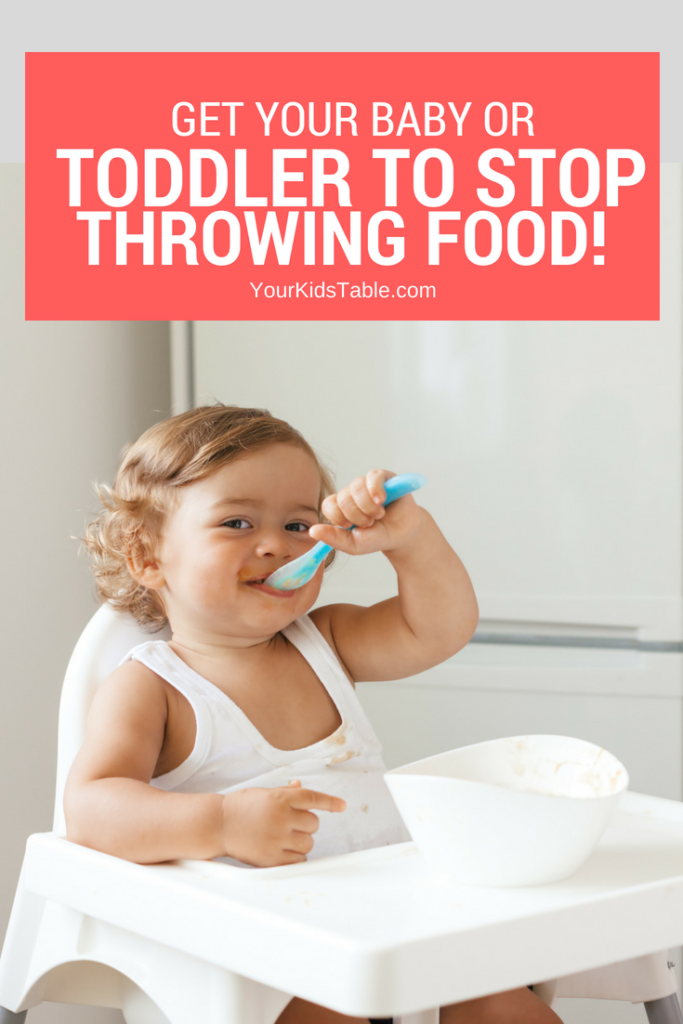 Too much rice cereal can also cause constipation.
Too much rice cereal can also cause constipation.
Arsenic is a common metal that has two forms – organic and inorganic – and many foods and beverages contain both forms in varying levels (including fruit juice). Arsenic is naturally present in water, soil, and air, but processes such as mining, manufacturing, and pesticide use have increased the level of inorganic arsenic in the environment.
Inorganic arsenic is more toxic than organic arsenic and in rare cases can cause certain cancers. (The U.S. Food and Drug Administration estimates that arsenic in rice causes four cases of lung and bladder cancer over a lifetime for every 100,000 people in the U.S.)
Early exposure to arsenic (in the womb, or at a very young age) may also be associated with impaired intellectual development.
Rice is the top dietary source of inorganic arsenic, both because it's a staple in people's diets all around the globe and because rice plants tend to absorb more arsenic than other plants.
Babies typically eat much more rice in relation to their weight than adults do, since rice cereal is often a big part of babies' diets when they first start eating solid foods.
While research shows that most rice cereal brands contain less arsenic than the federally recommended maximum, experts still say it's best to avoid relying on rice cereal as a main source of iron and other nutrients. Instead, give your baby cereal made from different kinds of grains, like oat, barley, whole wheat, and multigrain, since those contain less arsenic. If you do give your baby rice cereal, make sure it's part of a varied diet.
How much should my baby eat? A guide to baby food portions
- Community
- Getting Pregnant
- Pregnancy
- Baby names
- Baby
- Toddler
- Child
- Health
- Family
- Courses
- Registry Builder
- Baby Products
Advertisement
Wondering how much to feed your baby? This can be hard to figure out, especially when you're starting solids and most of your baby's food ends up on your little one or the floor. It's also difficult to determine how much an 8-month-old (or older baby) should eat – babies this age are more interested in solid foods but still get most of their nutrition from breast milk or formula. This visual guide to baby food portions can help you figure out how much your baby should eat at every stage.
It's also difficult to determine how much an 8-month-old (or older baby) should eat – babies this age are more interested in solid foods but still get most of their nutrition from breast milk or formula. This visual guide to baby food portions can help you figure out how much your baby should eat at every stage.
Photo credit: Karla Martin for BabyCenter
How much should my baby eat?
Do you worry that your baby is eating too little or too much? Your baby will self-regulate her food intake based on what their body needs, so let their appetite be your guide.
It's helpful to have a reference point, however. Here are photos of how much solid food a baby typically eats in a day. You can also ask your baby's doctor for feeding advice.
This visual guide shows:
- Portions for infants who are new to solids (typically 4 to 6 months)
- Two sample meals for a younger baby (6 to 8 months)
- Three sample meals and two snacks for an older baby (8 to 12 months) from a menu developed by the American Academy of Pediatrics (AAP)
Your little one may eat less or more than what's shown here.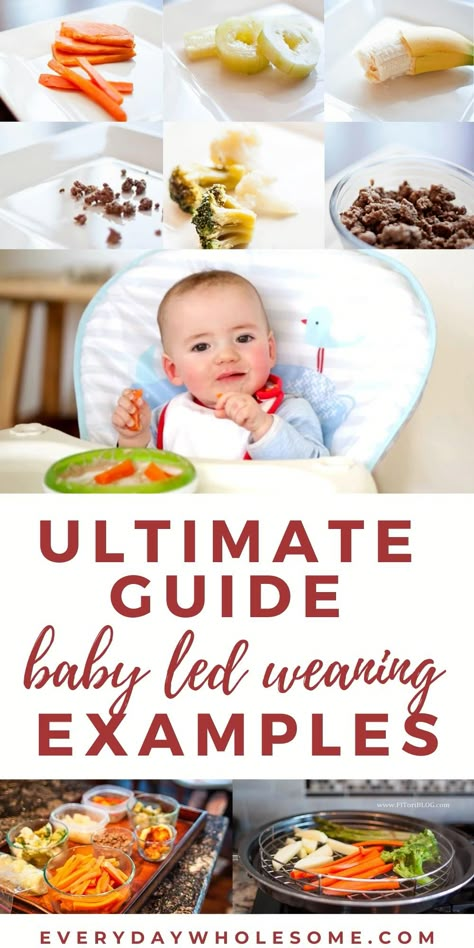 Your job is to provide a variety of healthy foods at regular intervals without pressure, and their job is to decide what and how much to eat.
Your job is to provide a variety of healthy foods at regular intervals without pressure, and their job is to decide what and how much to eat.
Photo credit: iStock.com / UntitledImages
Watch for signs your baby is full
Lots of factors – including activity level, growth spurts or plateaus, illness, and teething – will affect your baby's appetite, which can vary daily.
End feeding when they signal that they're done. Signs of being full include:
- Turning their head away
- Refusing to open their mouth for another bite after they've swallowed (resist the urge to encourage your baby to have one last spoonful)
- Leaning back in their chair
- Playing with the spoon or food rather than eating
Photo credit: Karla Martin for BabyCenter
How much a 4- to 6-month-old should eat
When your baby is developmentally ready for solids, typically around 4 to 6 months, talk to their doctor about introducing solid foods. The first bites are mostly about them getting used to the idea of having something different in their mouth.
The first bites are mostly about them getting used to the idea of having something different in their mouth.
- Start with a very small amount, 1 to 2 teaspoons, of a single-ingredient puree.
- Gradually increase to 1 to 2 tablespoons of food once a day.
- Follow your baby's fullness cues.
Popular first foods include pureed mango, banana, chicken, turkey, beef, peas, sweet potatoes, and infant cereal. It's up to you what food to start with, but wait 3 to 5 days between introducing each new food to make sure your baby doesn't have an allergic reaction or food intolerance. (And remember, no cow's milk or honey until age 1.)
Photo credit: Karla Martin for BabyCenter
How much a 6- to 8-month-old should eat
As your little one gets more comfortable with solids, you can increase the frequency of meals and variety of food.
- Transition from one to two meals a day, typically by 8 months.
- Over time, add a second food to each meal.
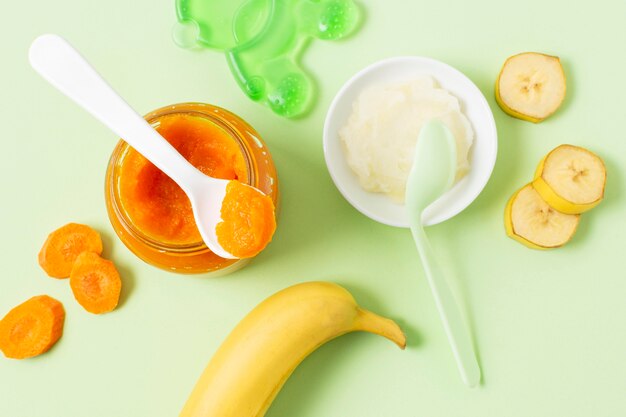 The photo above is an example of a meal with two foods.
The photo above is an example of a meal with two foods. - Once you've worked up to two meals with two foods each, aim for a balance of proteins, vegetables, fruits, and grains in their daily diet.
- Whenever you introduce a new food, start with a very small amount, a teaspoon or two, to allow your baby to get used to its flavor and texture.
- Start with a soupy consistency. Gradually add more texture as their eating skills improve.
Expect their intake of breast milk or formula to go down. They'll start drinking less of it as they eat more solid foods. Provide healthy options at mealtimes, and let them choose how much to eat.
Note: The jars in all photos are standard 4-ounce baby food jars.
Photo credit: Karla Martin for BabyCenter
Breakfast for a younger baby (6 to 8 months)
Cereal and fruit make an easy combination for a morning meal.
Grain: Iron-fortified, whole-grain infant cereal is a popular first grain.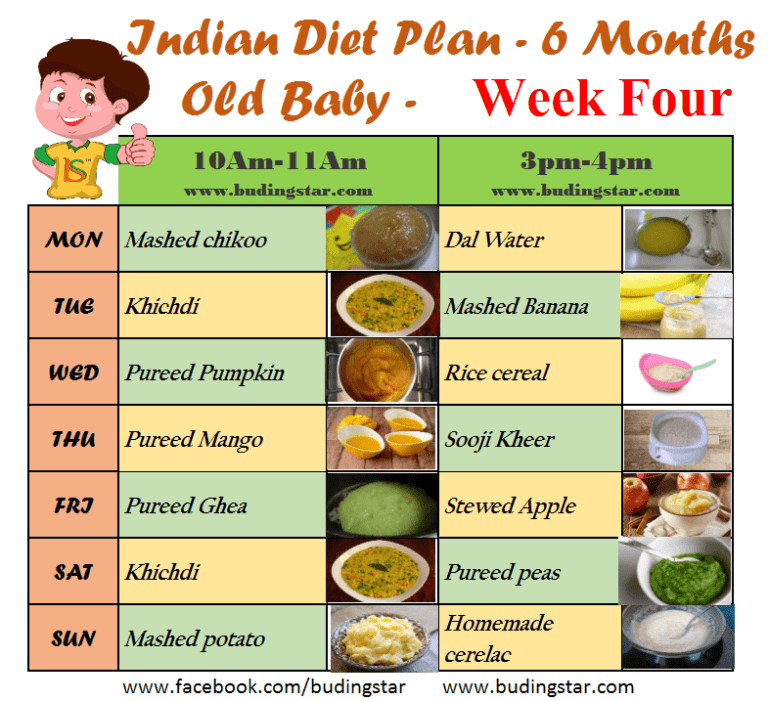 At 6 months, a typical daily portion of infant cereal mixed with breast milk or formula might be 2 to 3 tablespoons, increasing to 4 to 8 tablespoons (1/4 to 1/2 cup) by 8 months. (It's best to avoid rice cereal, though.)
At 6 months, a typical daily portion of infant cereal mixed with breast milk or formula might be 2 to 3 tablespoons, increasing to 4 to 8 tablespoons (1/4 to 1/2 cup) by 8 months. (It's best to avoid rice cereal, though.)
Fruit: Babies love the natural sweetness of fruits like pears, apples, berries, prunes, and stone fruits. Between 6 and 8 months, a baby will typically transition from about 2 to 3 tablespoons of fruit puree a day to 4 to 8 tablespoons (1/4 to 1/2 cup) of mashed or minced fruit.
Photo credit: Karla Martin for BabyCenter
Dinner for a younger baby (6 to 8 months)
If you serve a grain and fruit in the morning, consider offering a protein-rich food and vegetable later in the day. Your child may eat more or less than the amounts shown.
Protein: A baby might transition from eating 1 to 2 tablespoons of meat puree at 6 months to 2 to 4 tablespoons at 8 months, for example. Other good protein sources include cheese, unsweetened plain whole-milk yogurt, tofu, beans, and lentils.
Vegetables: Between 6 and 8 months, a baby will typically transition from about 2 to 3 tablespoons of vegetable puree a day to 4 to 8 tablespoons (1/4 to 1/2 cup). Try classic favorites like carrots, spinach, or butternut squash, as well as less traditional first foods such as parsnips, beets, or asparagus.
As your child's eating skills improve, gradually add more texture by dicing or mincing foods.
Photo credit: Karla Martin for BabyCenter
How much an 8- to 12-month-old should eat
By 8 months or so, your baby is likely getting the hang of eating and needs to eat more calories to support their growing body. But since their little belly can't hold a lot of food, they'll need to eat more often. Every baby is different, but this may be a good time to try offering a third solid food meal.
During this period:
- Continue to give your baby breast milk or formula.
- Add morning and afternoon snacks. (Some babies this age are happy with breast milk or formula as their snack, while others gravitate toward solid foods.
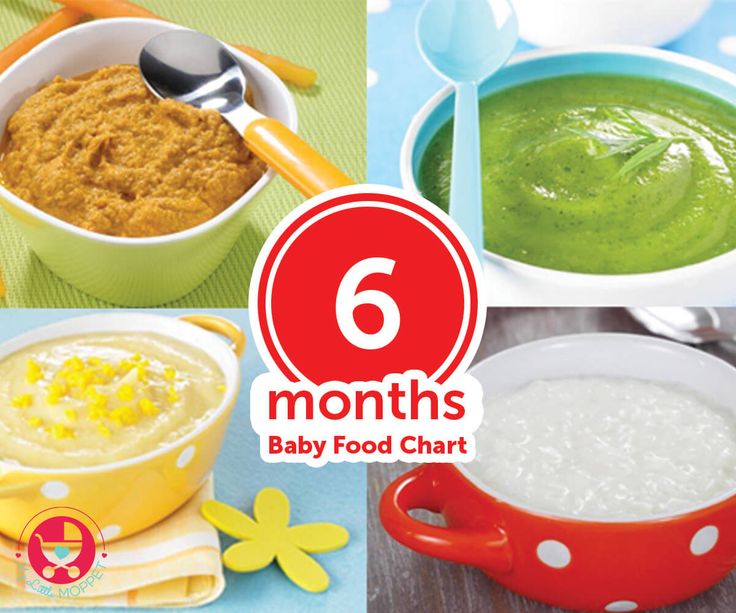 ) Once you've added a third meal and snacks, your baby will be eating or drinking something about every two to three hours.
) Once you've added a third meal and snacks, your baby will be eating or drinking something about every two to three hours.
- Continue to aim for a mix of proteins, vegetables, fruits, and grains.
- Introduce coarser and chunkier textures, for example, by dicing or mincing food instead of pureeing it, and graduate to soft finger foods as your baby's eating skills improve.
- Avoid foods with added sugars. Check the Nutrition Facts label on packaged foods, and try to steer clear of foods that list 1 gram or more of "Added Sugars."
- Provide healthy options, and let your baby choose how much to eat.
To visualize daily portions for an 8- to 12-month-old, check out the following photos of a typical day's menu for a baby this age, developed by the AAP.
Your child may eat more or less than these amounts. If you're concerned about how much your baby is eating, talk to their doctor for advice.
Photo credit: Karla Martin for BabyCenter
Breakfast for an older baby (8 to 12 months)
The AAP sample menu for a baby 8 to 12 months features a breakfast consisting of:
- 4 to 8 tablespoons (1/4 to 1/2 cup) whole-grain infant cereal mixed with formula or breast milk
- 4 to 8 tablespoons (1/4 to 1/2 cup) diced fruit
Note: This is an example.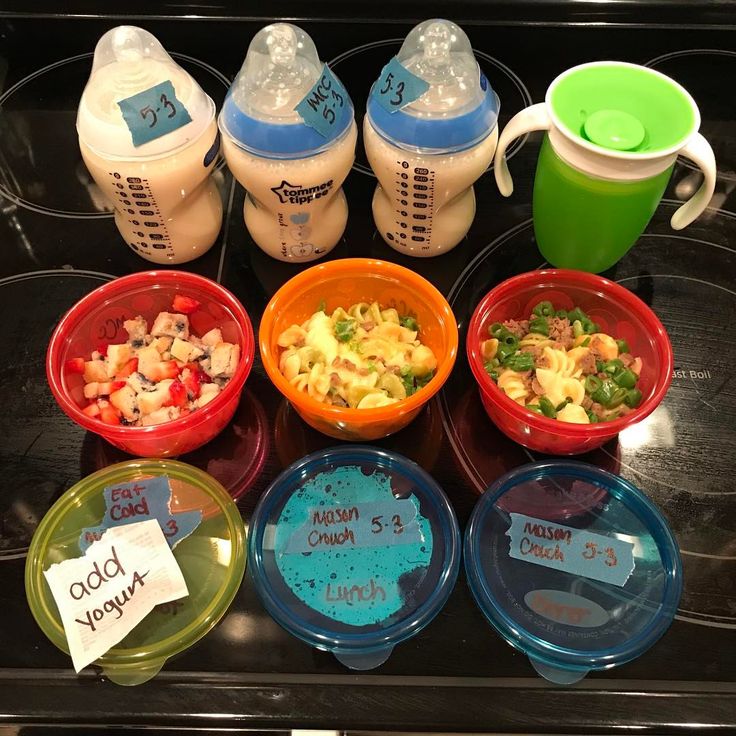 Your baby may eat different foods and amounts.
Your baby may eat different foods and amounts.
Photo credit: Karla Martin for BabyCenter
Morning snack for an older baby (8 to 12 months)
The AAP sample menu for a baby 8 to 12 months features a morning snack consisting of:
- 4 tablespoons (1/4 cup) diced cheese or cooked vegetables
Note: This is an example of a morning snack, which babies typically add sometime between 8 and 12 months. Your baby may eat different foods and amounts.
Photo credit: Karla Martin for BabyCenter
Lunch for an older baby (8 to 12 months)
The AAP sample menu for a baby 8 to 12 months features a lunch consisting of:
- 4 to 8 tablespoons (1/4 to 1/2 cup) unsweetened plain whole-milk yogurt or cottage cheese, or minced meat
- 4 to 8 tablespoons (1/4 to 1/2 cup) diced or mashed yellow or orange vegetable
Note: This is an example. Your baby may eat different foods and amounts.
Photo credit: Karla Martin for BabyCenter
Afternoon snack for an older baby (8 to 12 months)
The AAP sample menu for a baby 8 to 12 months features an afternoon snack consisting of:
- 4 tablespoons (1/4 cup) diced fruit or unsweetened plain whole-milk yogurt
- 1 whole-grain teething biscuit or cracker
Note: This is an example of an afternoon snack, which babies typically add sometime between 8 and 12 months.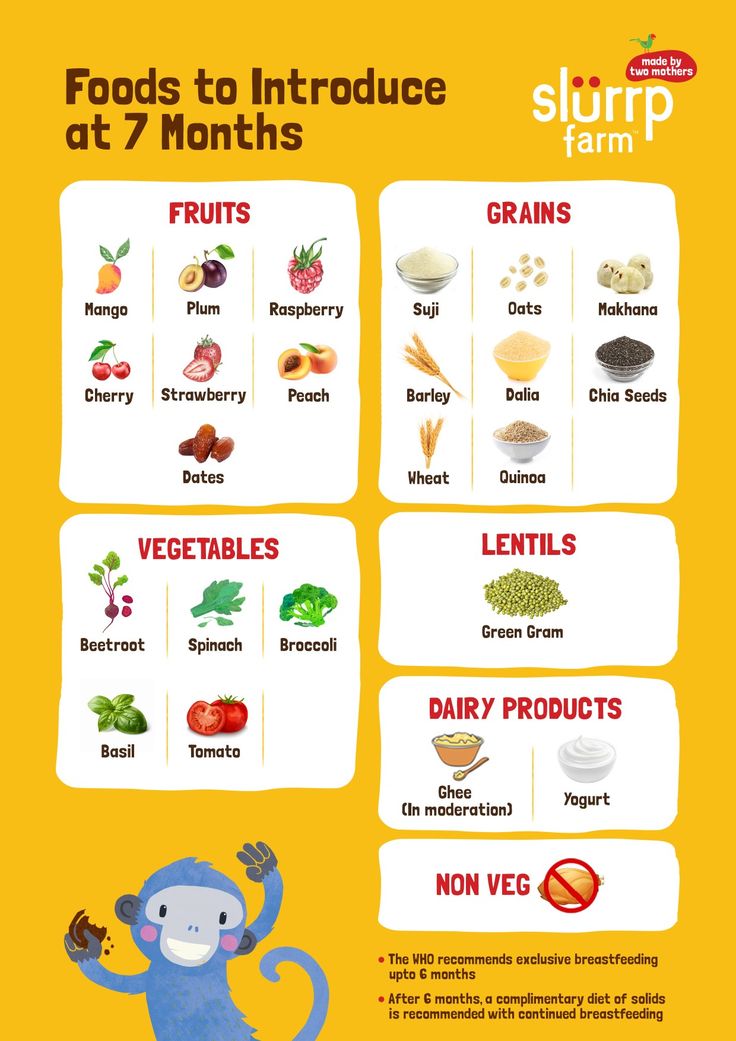 Your baby may eat different foods and amounts.
Your baby may eat different foods and amounts.
Photo credit: Karla Martin for BabyCenter
Dinner for older baby (8 to 12 months)
The AAP sample menu for a baby 8 to 12 months features a dinner consisting of:
- 4 tablespoons (1/4 cup) minced or ground poultry or meat, or diced tofu
- 4 to 8 tablespoons (1/4 to 1/2) cup diced, cooked green vegetable
- 4 tablespoons (1/4 cup) noodles, pasta, rice, or potato
- 4 tablespoons (1/4 cup) diced fruit
Note: This is an example. Your baby may eat different foods and amounts.
Photo credit: Karla Martin for BabyCenter
How much should my baby drink once they start eating solids?
Breast milk or formula will fully meet your child's hydration needs until they're about 6 months old. They may start drinking less as solid foods become a bigger part of their diet. Here are typical daily amounts by age – your baby's intake may be different, however.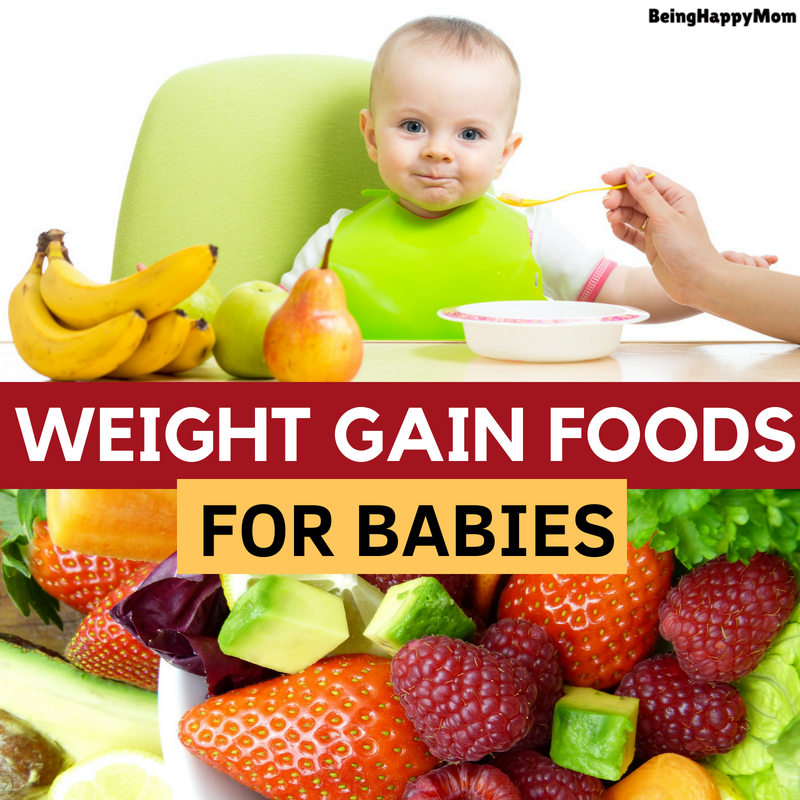
6 to 8 months: 24 to 32 ounces of formula, or continued breastfeeding on demand
8 to 12 months: 24 ounces of formula, or continued breastfeeding on demand
Water: You can offer your baby water once they start eating solids, but let them self-regulate how much they drink. The Centers for Disease Control and Prevention (CDC) recommends giving babies who are 6 to 12 months old 4 to 6 ounces of water a day, but what your baby decides to drink may vary. They may drink more on a hot day, for example.
Avoid juice: Juice isn't recommended for babies younger than 12 months.
Photo credit: iStock.com / SDI Productions
Your baby has the final say
Keep in mind that these portions are an estimate. The truth is, every baby is different, and there's no set amount of food that's appropriate for every baby at every stage.
If you're worried about whether your baby is eating enough – or too much – the best advice is to look for and respond to signs that your baby is full.
Your baby's doctor will chart their weight gain at regular intervals. If the doctor sees a consistent growth curve and doesn't have other concerns, your baby is most likely eating the right amount of food.
Hungry for more?
Age-by-age guide to feeding your baby
The 10 best foods for babies
The worst foods for babies
Using spices and seasoning in baby food
Sources
BabyCenter's editorial team is committed to providing the most helpful and trustworthy pregnancy and parenting information in the world. When creating and updating content, we rely on credible sources: respected health organizations, professional groups of doctors and other experts, and published studies in peer-reviewed journals. We believe you should always know the source of the information you're seeing. Learn more about our editorial and medical review policies.
AAP. 2021. Starting solid foods. American Academy of Pediatrics. https://www.healthychildren.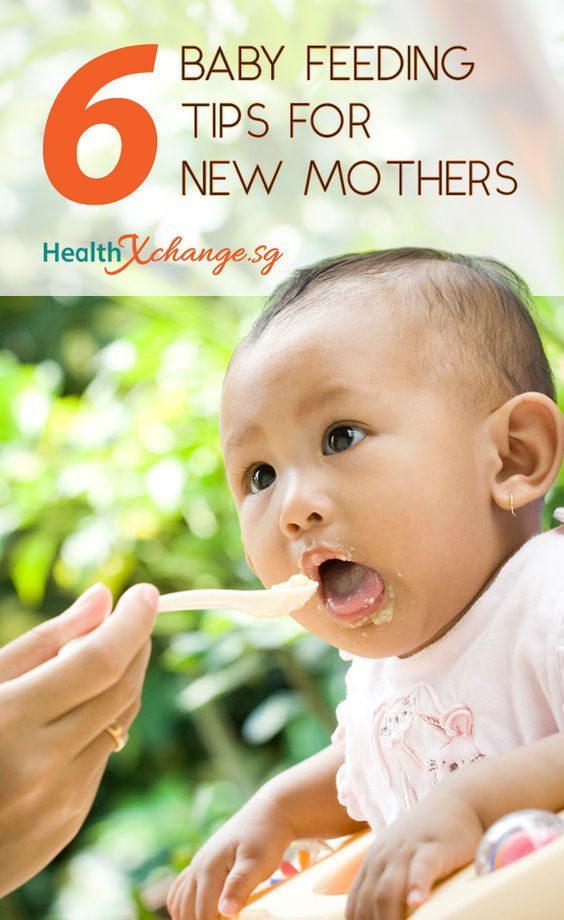 org/English/ages-stages/baby/feeding-nutrition/Pages/Starting-Solid-Foods.aspx [Accessed February 2022]
org/English/ages-stages/baby/feeding-nutrition/Pages/Starting-Solid-Foods.aspx [Accessed February 2022]
AAP. 2021. Sample menu for an 8 to 12 month old. American Academy of Pediatrics. https://www.healthychildren.org/English/ages-stages/baby/feeding-nutrition/Pages/Sample-One-Day-Menu-for-an-8-to-12-Month-Old.aspx [Accessed February 2022]
CDC. 2020. How much and how often to feed. U.S. Centers for Disease Control and Prevention. https://www.cdc.gov/nutrition/InfantandToddlerNutrition/foods-and-drinks/how-much-and-how-often.html [Accessed February 2022]
Stanford University. Undated. Feeding guide for the first year. Stanford Children's Health and Lucile Packard Children's Hospital Stanford. https://www.stanfordchildrens.org/en/topic/default?id=feeding-guide-for-the-first-year-90-P02209 [Accessed February 2022]
USDA. 2020. ChooseMyPlate.gov. U.S. Department of Agriculture. https://www.choosemyplate.gov/ [Accessed February 2022]
USDA. 2020. Infant nutrition and feeding. U.S. Department of Agriculture. https://wicworks.fns.usda.gov/resources/infant-nutrition-and-feeding-guide [Accessed February 2022]
U.S. Department of Agriculture. https://wicworks.fns.usda.gov/resources/infant-nutrition-and-feeding-guide [Accessed February 2022]
USDA and DHHS. 2020. Dietary Guidelines for Americans, 2020-2025. 9th Edition. U.S. Department of Agriculture and U.S. Department of Health and Human Services. https://DietaryGuidelines.gov [Accessed February 2022]
Elizabeth Dougherty
Elizabeth Dougherty is a veteran parenting writer and editor who's been contributing to BabyCenter since 2015. She's an intrepid traveler, devoted yogi, and longtime resident of Silicon Valley, where she lives with her husband and son.
Proper nutrition of a child is a guarantee of health - Children's City Polyclinic No. 1
Every parent wants his child to grow up healthy, smart, happy.
From childhood, we must teach our children to choose from the variety of foods that are really good for health. The nutrition of children is somewhat different from the nutrition of adults.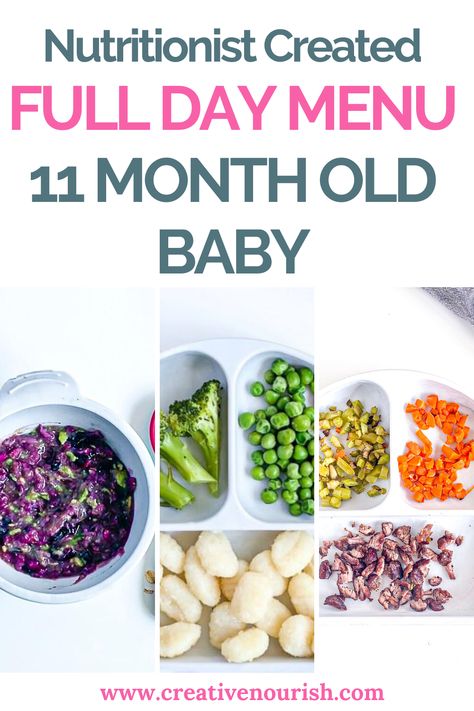 If the child's nutrition system is built correctly, then the child develops normally, both physically and mentally.
If the child's nutrition system is built correctly, then the child develops normally, both physically and mentally.
Make your family's way of life by introducing your child to proper nutrition every day. There is no need to arrange constant lectures from this on the topic of what is useful and what is harmful. By actively communicating with your child, setting an example, you instill good eating habits.
Only good things should be spoken at the table. The situation should help the child to relax, then the appetite will be good, and the mood will be friendly. Children can help you with serving and decorating dishes. When you serve vegetables and fruits on the table, ask the children what vitamins and minerals they contain and why they are so useful. In order to organize the proper nutrition of the child, you need to follow several important rules:
Rule 1
Food should be varied.
This is an important condition for the child's body to receive all the substances necessary for growth and development.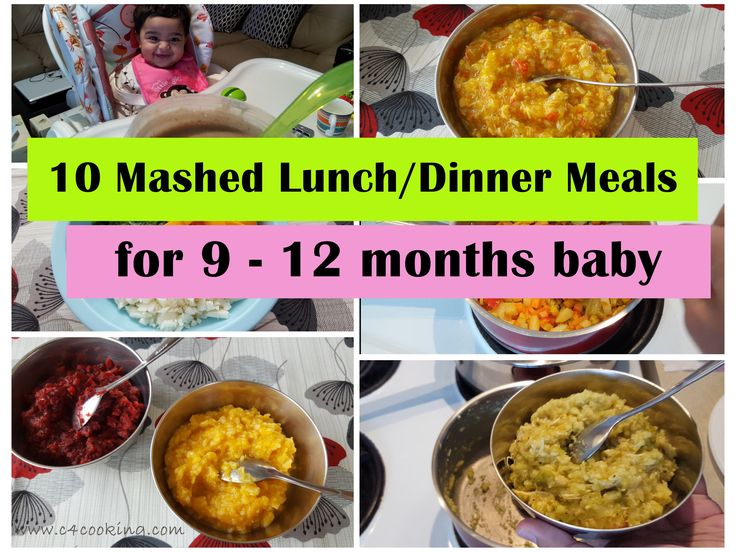 Every day, the child's menu should include: fruits and vegetables; meat and fish; milk and dairy products; grain products (bread, cereals, cereals). Insufficiency or excess of food consumed by a child can adversely affect the activity of the gastrointestinal tract, contribute to metabolic disorders, increase overweight (even to various degrees of obesity) or lead to malnutrition.
Every day, the child's menu should include: fruits and vegetables; meat and fish; milk and dairy products; grain products (bread, cereals, cereals). Insufficiency or excess of food consumed by a child can adversely affect the activity of the gastrointestinal tract, contribute to metabolic disorders, increase overweight (even to various degrees of obesity) or lead to malnutrition.
If the child refuses, there is a healthy dish, offer him to experiment and make the dish unusual.
So, with the help of dried fruits and nuts, you can put a funny face on porridge, use ketchup and greens to draw a pattern on scrambled eggs, put mashed potatoes on a plate in the form of a snowman figure, etc.
What should not be used in children's nutrition:
- Offal, except liver, tongue, heart; blood, liver, raw smoked sausages.
- Deep-fried foods and culinary products, chips.
- Curds, condensed milk with vegetable fats.
- Koumiss and fermented milk products containing ethanol (more than 0.
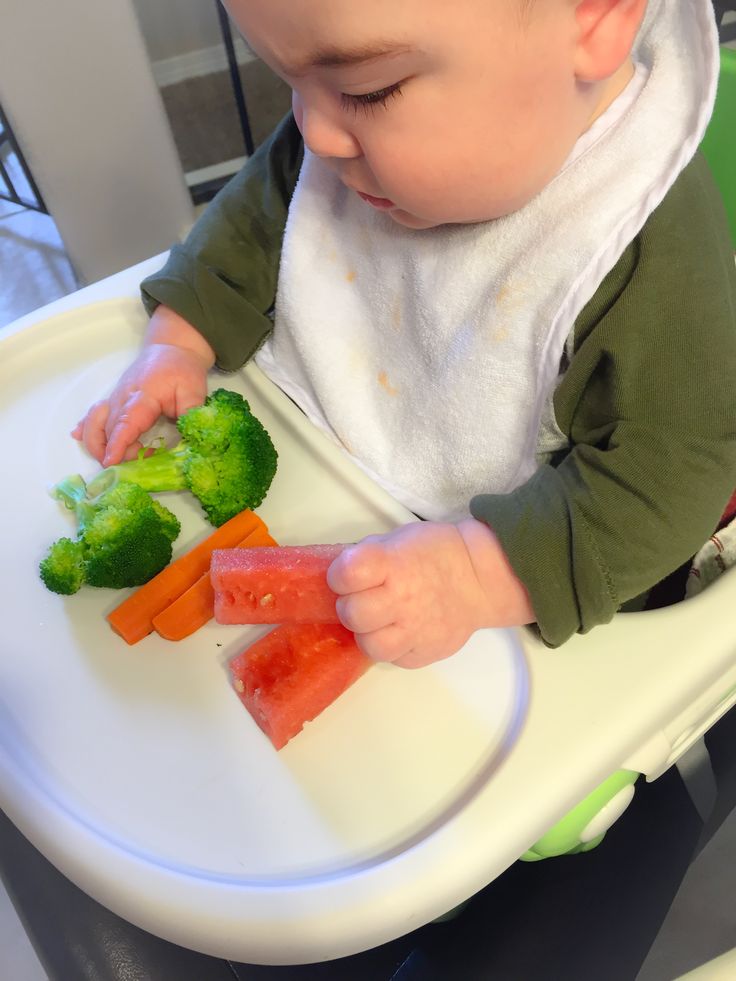 5%).
5%). - Cream confectionery containing vegetable protein.
- First and second courses based on fast food concentrates.
- Vinegar, mustard, horseradish, hot peppers and other hot spices and food products containing them, including hot sauces, ketchups, mayonnaises and mayonnaise sauces.
- Pickled vegetables and fruits.
- Natural coffee and carbonated drinks, apricot kernels, peanuts.
- Products, including confectionery, containing alcohol.
- Food products containing a large amount of food additives in their composition (information is indicated by the manufacturer on consumer packaging).
- Dry concentrates for cooking first and second courses (soups, Dosherak vermicelli, cereals).
Rule 2
The child should eat regularly.
Compliance with the diet of children is of great importance for the absorption of nutrients by the body.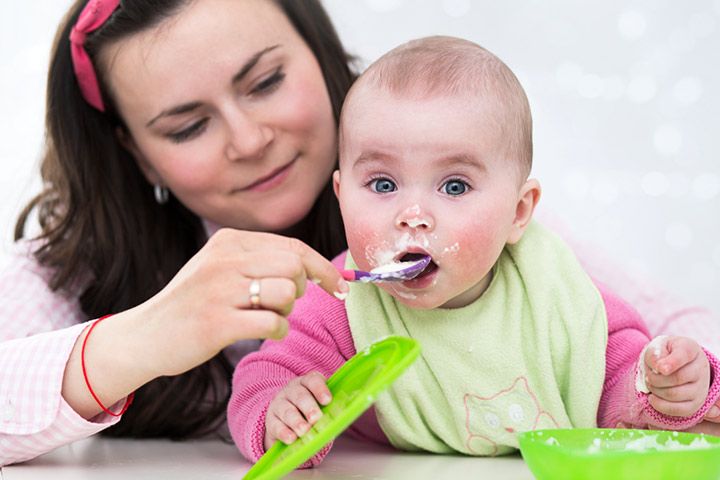 Preschool children are recommended to eat 4-5 times a day, every 3 hours, at the same time, distributing the diet as follows: breakfast - 25%, lunch - 35%, afternoon snack - 15%, dinner - 25% . At school age, it is advisable to have four meals a day, every 4 hours with an even distribution of the daily ration: breakfast - 25%, second breakfast - 20%, lunch - 35%, dinner - 20%.
Preschool children are recommended to eat 4-5 times a day, every 3 hours, at the same time, distributing the diet as follows: breakfast - 25%, lunch - 35%, afternoon snack - 15%, dinner - 25% . At school age, it is advisable to have four meals a day, every 4 hours with an even distribution of the daily ration: breakfast - 25%, second breakfast - 20%, lunch - 35%, dinner - 20%.
Try to stop snacking and teach your child to eat only at the table. If this still doesn't work, offer fruit, biscuits, juice for a snack - food that will help drown out hunger, but will not ruin your appetite.
Proper organization of meals at school in the form of hot school breakfasts and lunches is an important health-improving measure for children-students in extended-day groups, whose diet should be 50-70% of the daily norm, which parents, unfortunately, have little are paying attention. Eating sandwiches, pizza, chips, chocolate bars is harmful because - this food is inferior in composition and also irritates the stomach, contributing to the development of gastritis.
Rule 3
A child's food should replenish his daily energy expenditure.
If your child is overweight, limit the amount of sweets and high-calorie desserts, empty the refrigerator. Put a bowl of fruit on the table, a plate of whole grain bread. Children can eat fruits without any restrictions, it is almost impossible to overeat them, and they are very useful. With a lack of any mineral substance or vitamin, the child himself will ask for the apple or even greens he needs.
Try to get your child involved in sports, take walks together, even if little by little, but regularly.
Thus, building proper nutrition for children requires taking into account the characteristics of the child's body, knowledge of certain rules and principles of healthy nutrition.
The material was prepared by the editorial and publishing department of GBUZ JSC "CMP" - 2020
Child nutrition in the 2nd year of life: regimen, diet, menu, necessary products | Mamovediya
The child in this period of life grows intensively and therefore must receive nutrition that quantitatively and qualitatively satisfies the needs of his body.
Nutrition should be rational: balanced and consistent with the daily routine. Balance - the inclusion of all the necessary nutrients (proteins, fats, carbohydrates, vitamins, trace elements) in the appropriate proportions that the child's body can absorb.
Nutrition is considered rational if it meets the age needs of the child and is carried out according to the daily routine.
In addition, the so-called rational nutrition includes the culinary processing of food used for a given age, and the correct methodological methods of parents in the process of feeding a child.
The surroundings of the baby during the meal, the appearance of the dishes served should stimulate the child's appetite.
Child's appetite is a state of organic need for food, expressed in the child's desire to eat. At the same time, an adequate positive attitude of the child to food is noted.
A good appetite, as a rule, depends not only on how well the menu is compiled, but also on the correct organization of the feeding process.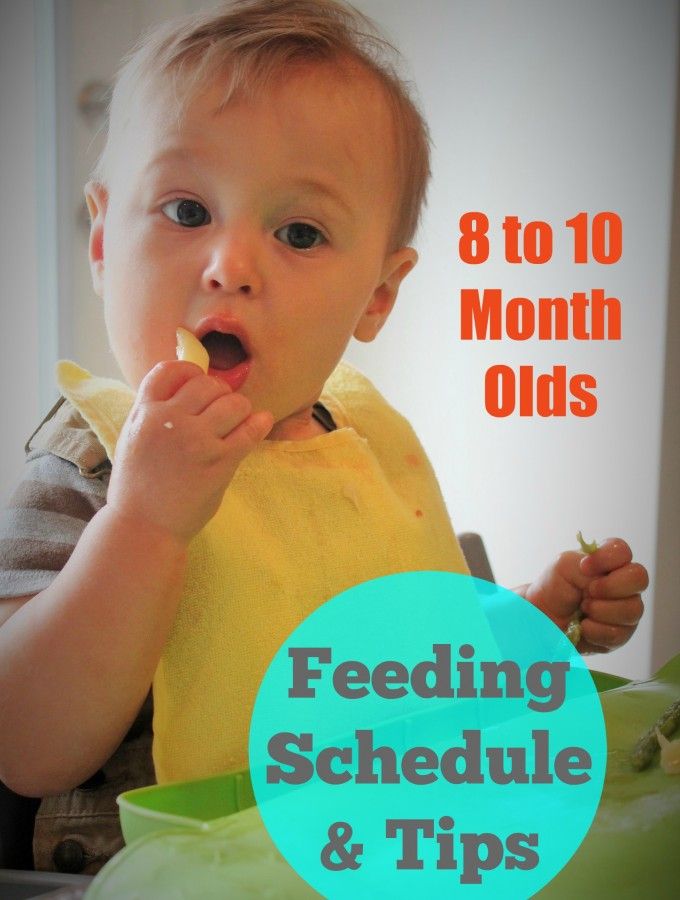 To form and maintain a good appetite, parents must clearly know: what, when and how to feed the child.
To form and maintain a good appetite, parents must clearly know: what, when and how to feed the child.
How nice it is to feed a child who has a good appetite. It brings pleasure to adults and great benefits for the baby. However, very often it is necessary to observe cases of violation of normal appetite from small deviations (decrease in appetite, refusal of certain dishes) up to its complete absence (anorexia - as it is called in medical practice).
A child with a decrease or lack of appetite at the mere sight of writing or a reminder of food expresses protest, turns away, defends himself, tightly closes his lips and teeth. It looks like an unnatural negative reaction of the baby to food. Why does a child lose his appetite? Who is to blame for this? The reasons often lie in the wrong method of feeding (strong pressure on the child's tongue with a spoon, the child's lack of interest in food), in the negative sensations associated with eating (too hot food, poor taste), improper organization of the situation during feeding (distraction with a book, toy, punishment), etc.
Many parents, seeing a decrease in appetite, try to force-feed their child, but this further reinforces the child's negative attitude towards food and everything connected with it. This is strictly prohibited.
If a child suddenly lost his appetite, first of all think about whether you could have made mistakes in the process of upbringing and feeding, in especially persistent cases, you should consult a pediatrician.
During feeding, do not forget to introduce the child to the names of dishes (soup, cutlet, compote, etc.) and the properties of objects (food is tasty, sweet, sour, salty, hot, cold, a large spoon, a small one, etc.) .). In this way, the child will form the first ideas, concepts.
Eating processes should be organized so that the child has a desire to eat. Before eating, you should arrange a calm pause after a long walk or noisy and active games.
You should not give your child new interesting toys shortly before feeding, and quickly take them away before eating.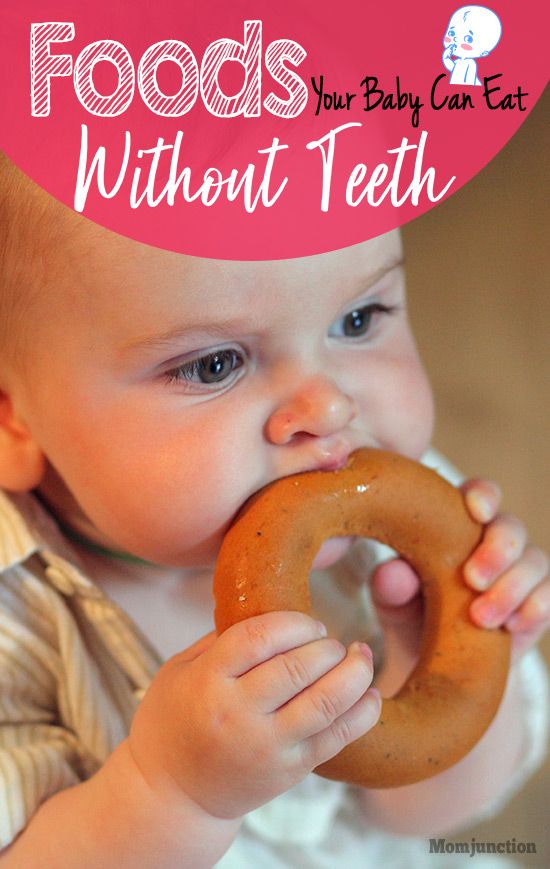 By doing this, you will cause a strong emotional reaction that will slow down food arousal and reduce appetite.
By doing this, you will cause a strong emotional reaction that will slow down food arousal and reduce appetite.
While eating with a child, one should only talk about what is connected with this process, concentrating his attention on food, developing the child's active participation in eating.
A child's appetite is increased not only by deliciously cooked food, but also by its beautiful design, attractive dishes specially painted for children. Children should only be seated at the table when food has already been served. You should not put all the dishes on the table at once, the child is distracted from the first dish, reaches for the third or second, as a result, the sequence of eating is disrupted. Remember that many disorders in the health of the baby are associated with errors in his diet.
By the age of 1 year 3 months, the baby can already eat solid food with a spoon, and at 1 year 6 months he can eat any food - thick and liquid. Try to develop these independent skills and abilities that are very important for later life in your son or daughter. How joyful it is to look at a baby who skillfully takes food from a plate with a spoon, without mistake brings it to his mouth and actively removes it with his lips. Something, of course, still pours past from the spoon and remains on the lips or chin of the child, however, these errors in eating will soon pass, and the baby will learn to carefully eat the entire portion. Remember that a large amount of food contributes to a decrease in appetite, and an insufficient one does not cause a feeling of fullness.
Try to develop these independent skills and abilities that are very important for later life in your son or daughter. How joyful it is to look at a baby who skillfully takes food from a plate with a spoon, without mistake brings it to his mouth and actively removes it with his lips. Something, of course, still pours past from the spoon and remains on the lips or chin of the child, however, these errors in eating will soon pass, and the baby will learn to carefully eat the entire portion. Remember that a large amount of food contributes to a decrease in appetite, and an insufficient one does not cause a feeling of fullness.
A child at this age should be able to chew food. Make sure that he does not keep the pieces in his mouth for a long time, but swallows them in time.
A child of the 2nd year of life is fed 4 times a day with an interval of 3.5-4.5 hours. However, in the first half of the year, the baby can receive another fifth feeding - kefir or milk at 23-24 hours if he wakes up at night or at 6 o'clock in the morning.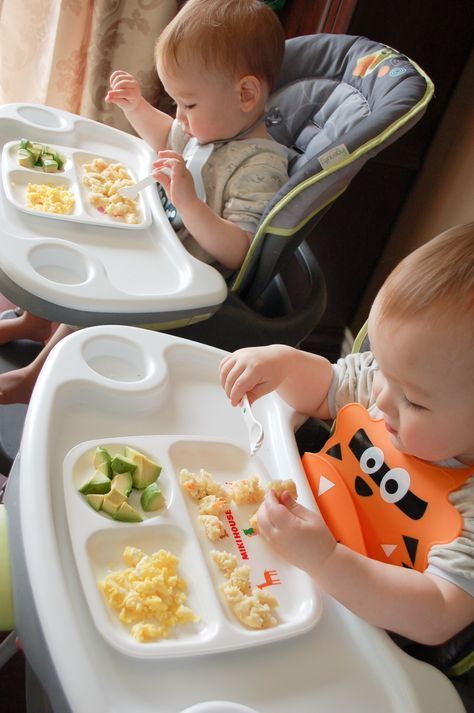
Establishing rational nutrition is painstaking and very responsible work, but if you do it systematically, without giving "indulgence" to yourself and your child, then your reward will be good health and good physical development of the baby.
When compiling the menu, it is necessary to correctly distribute how much and what kind of food the child will receive during the day. Feed your baby 4-5 times a day. In the morning it is better to cook dairy dishes, lunch should always consist of soup, meat in the form of mashed potatoes or meatballs with a vegetable side dish, compote or jelly, fruits, kefir are given in the afternoon, a vegetable dish is prepared for dinner.
The one-time amount of food consumed in children of the 2nd year of life is different - up to 1.5 years, somewhat less than in the second half of the year.
Under no circumstances should children of this age be given food from the common table This is very harmful. Malnutrition of a child older than a year will undoubtedly affect his health in the future. Injury by coarse food to the still unprotected mucous membrane of the child's stomach, the stressed state of the organs of the gastrointestinal tract lead to the formation of early gastritis, enteritis, cholecystitis and other diseases.
Malnutrition of a child older than a year will undoubtedly affect his health in the future. Injury by coarse food to the still unprotected mucous membrane of the child's stomach, the stressed state of the organs of the gastrointestinal tract lead to the formation of early gastritis, enteritis, cholecystitis and other diseases.
The menu can be diversified by replacing meat with cottage cheese, fish, eggs, introducing a variety of vegetable or cereal dishes, changing the culinary processing of food (mashed potatoes, cutlets, jelly, compote, etc.), improving its taste, adding greens (dill, parsley, celery, etc.).
If a dairy dish is served for breakfast, then in the afternoon you should feed the baby with vegetables and vice versa; if vegetable soup is prepared for lunch, then the second dish should be cereal, etc. To maintain appetite, make sure that meals are not repeated during the day.
This set of products does not have to be used every day, and it is practically difficult, for example, to measure 3 g of cheese for a child.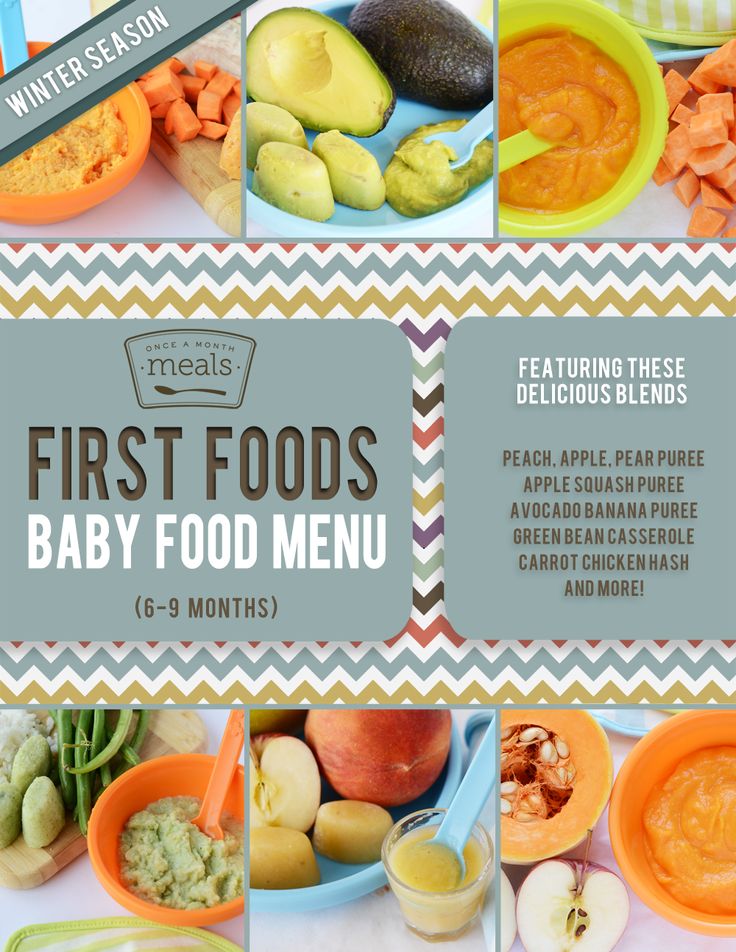 It is important that during the week the proposed list of products be used in baby food. Therefore, cheese can be used once a week and immediately in the amount of 20 g (3 x 7, say, give the baby vermicelli with grated cheese for breakfast.
It is important that during the week the proposed list of products be used in baby food. Therefore, cheese can be used once a week and immediately in the amount of 20 g (3 x 7, say, give the baby vermicelli with grated cheese for breakfast.
A few words about food products intended for baby food, or rather, their brief description.
Milk and dairy products. Natural milk can be given to a child only after boiling. One-day kefir and cottage cheese are very useful. Milk should be boiled in a heavy-bottomed saucepan with the lid closed. When preparing dishes from milk (porridge, mashed potatoes), raw milk is added and allowed to boil once with ready-made cereals or vegetables. Milk must not be boiled twice. It should be remembered that excess milk reduces the child's appetite, so milk should not be given to quench thirst instead of water.
Oils. In the diet of children of the 2nd year of life, both butter and vegetable oil can be used, and the amount of vegetable oil should not exceed 10-15% of the total amount of oil consumed per day (i.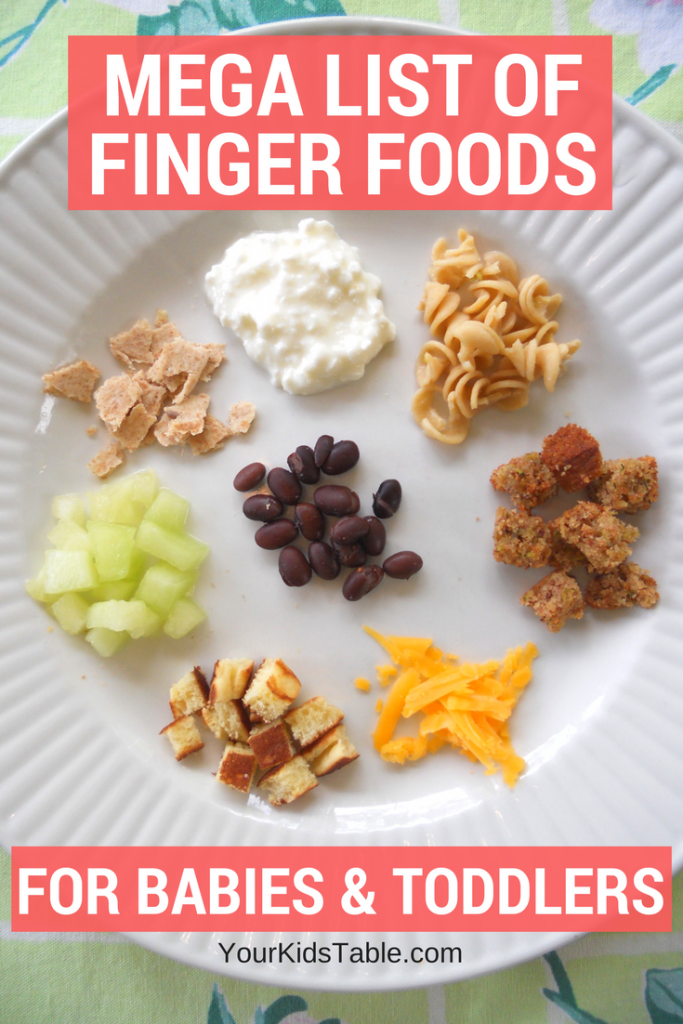 e., not more than 2 g per day) . Vegetable oil should be stored in a sealed container, protected from light and air. It cannot be boiled, so it is better to lay it in the finished dish. In the diet of children, it is not recommended to use refractory fats - beef, pork, cooking oil, and margarine.
e., not more than 2 g per day) . Vegetable oil should be stored in a sealed container, protected from light and air. It cannot be boiled, so it is better to lay it in the finished dish. In the diet of children, it is not recommended to use refractory fats - beef, pork, cooking oil, and margarine.
Meat and meat products. Lean beef, rabbit meat, chicken are useful for children You can use offal - liver, tongue, heart, brains, chicken giblets. Meat should not be soaked in water, as this transfers some of the nutrients into the water. The liver should be fried under the lid and given to the child in a puréed semi-liquid form. For children under 1.5 years old, meat, like other food, should be cooked pureed. This is due to the absence of chewing teeth in a child at this age, the underdevelopment of chewing muscles and the insufficient activity of digestive juices.
Fish and fish products. Children can only be given low-fat varieties of fish - hake, cod, sea bass, pike perch. Fish is equivalent to meat in its nutritional properties, but, in addition, it contains trace elements important for the growth and development of the child (iodine, phosphorus, copper, etc.). Keto or sturgeon caviar should be treated with caution, as it can cause unwanted allergic reactions in children.
Fish is equivalent to meat in its nutritional properties, but, in addition, it contains trace elements important for the growth and development of the child (iodine, phosphorus, copper, etc.). Keto or sturgeon caviar should be treated with caution, as it can cause unwanted allergic reactions in children.
Eggs. It is recommended to give children only chicken eggs and be sure to boil them. Raw eggs should not be served, as they can be contaminated with pathogens due to the porosity of the shell, and raw protein is poorly digested in the stomach, and raw yolk can cause allergies. Duck, goose, and eggs of other birds are prohibited from being included in the children's menu.
Bread and bakery products. It is good for children to give both rye and wheat bread. You can give bagels, bagels, crackers, by the way, children love them very much.
Cereals and pasta. The most valuable in terms of mineral composition are bean, buckwheat, oat and millet groats. But you can use their other types - semolina, peas, as well as pasta. The groats are boiled in water (oatmeal and buckwheat - for l '/g h, millet - 1 hour, semolina - 20 minutes), then unboiled milk is added, and after removing the porridge from the heat - butter and sugar to taste.
But you can use their other types - semolina, peas, as well as pasta. The groats are boiled in water (oatmeal and buckwheat - for l '/g h, millet - 1 hour, semolina - 20 minutes), then unboiled milk is added, and after removing the porridge from the heat - butter and sugar to taste.
Sugar and confectionery . In children's food - in tea, milk, cereals, compotes, kissels - you can add sugar, but in moderation. Remember that excess sugar is harmful to a child, as it can contribute to obesity or diabetes. Other sweets are recommended marmalade, jams, marshmallows, marshmallows, cookies, especially oatmeal, waffles. Do not give children cakes with rich creams, chocolates and chocolates, as well as lozenges, especially rounded ones.
Vegetables, fruits, berries, herbs. All these products are very useful for young children, because, in addition to vitamins, they contain fiber, organic acids, pectin, tannins and volatile substances, as well as minerals and trace elements.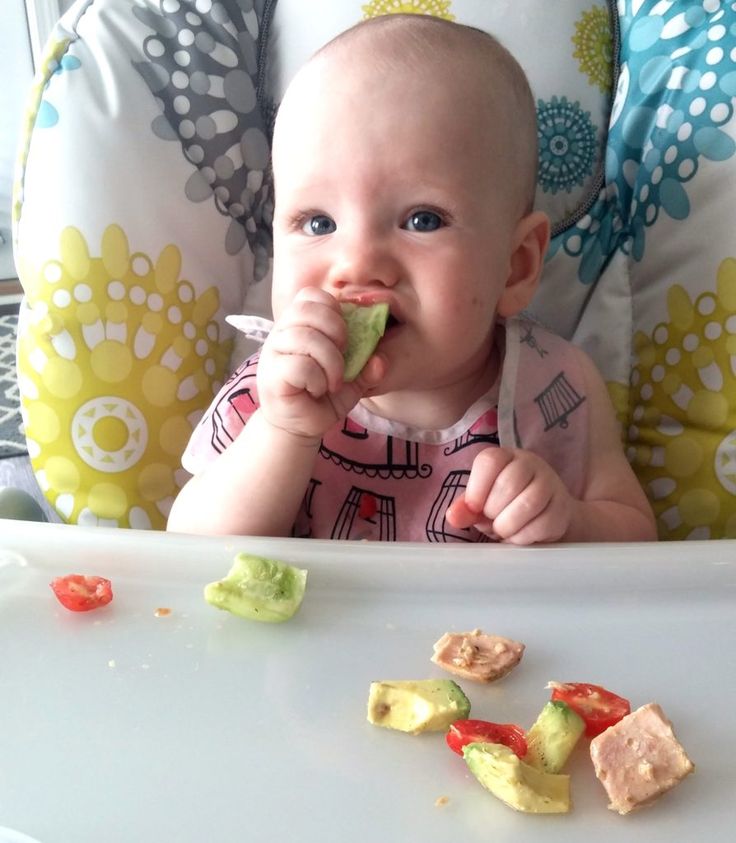 Raw vegetables can also be used in children's nutrition. At the same time, they must be thoroughly washed, poured over with boiling water, and then grated on a fine grater. Fruits and berries are best given fresh to a child, and raw juice should be added to a boiled fruit and berry dish. In the nutrition of children, you can use canned vegetables and fruits specially prepared for baby food, as well as compotes, juices, freshly frozen and dried vegetables and fruits. Boil vegetables and fruits in a saucepan with a lid to preserve as many vitamins as possible.
Raw vegetables can also be used in children's nutrition. At the same time, they must be thoroughly washed, poured over with boiling water, and then grated on a fine grater. Fruits and berries are best given fresh to a child, and raw juice should be added to a boiled fruit and berry dish. In the nutrition of children, you can use canned vegetables and fruits specially prepared for baby food, as well as compotes, juices, freshly frozen and dried vegetables and fruits. Boil vegetables and fruits in a saucepan with a lid to preserve as many vitamins as possible.
From 1 year to 1 year 3 months
You can be told about the methods of preparing various children's meals by a district nurse or a nurse in a healthy child's office in a children's polyclinic.
The menu for a baby at this age can be compiled as follows:
Breakfast
- Porridge (vegetable puree) -150.0
- Tea with milk (milk) -100.0
- Bread with butter 9004
- Lunch
- Soup (vegetable, meat) -100.
 0
0 - Puree meat (cutlet) - 40.0
- Garnish (vegetable puree, vermichel) - 50.0
- compote (fruit juice) –100.0
Polterine
- - 30.0
- kefir (milk) with a bun of –150.0
- Fruits - 50.0
Dinner
- Puree vegetable (porridge) –150.0
- tea with milk --150.0
- Kefir (milk) -150.0
Recall that the second dinner is provided for those children who wake up at 23-24 hours.
From 1 year 3 months to 1 year 6 months vegetable oil. This is a very healthy dish, because, in addition to the vitamins it contains, it makes the baby chew food thoroughly, which means it stimulates the development of the child's chewing apparatus.
The following foods can be included in a sample menu:
breakfast
Porridge (vegetable puree) –150.
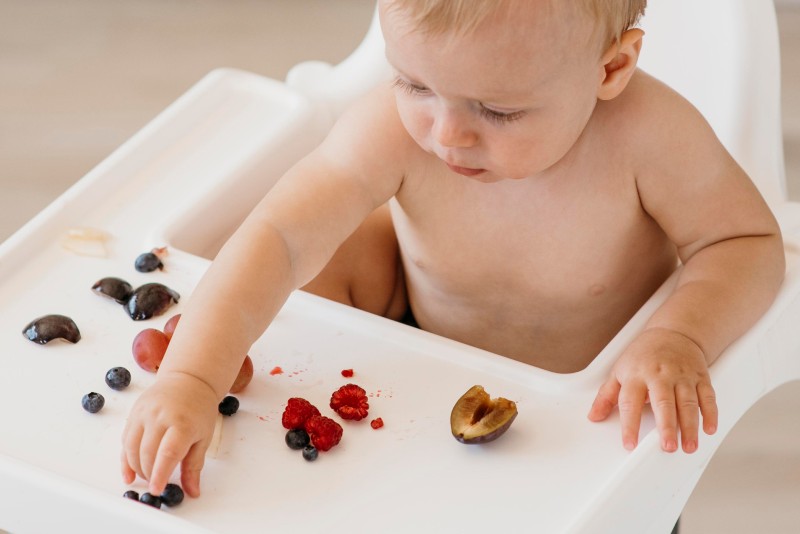 0
0 Tea with milk (milk) –150.0
Bread with oil
- vegetable salad - 10.0
- 44 Soup —150.0
- Cutlet (meat, fish, liver) — 50.0
- Garnish (cereal, vegetable) — 80.0
- Compote —100.0
- Snack
- Cottage cheese — 50045
- Fruit -100.0
- Tea with biscuits -150.0
Dinner
- Vegetable puree (porridge) —150.0
- Kefir (milk) —150.0
From 1 year 6 months to 1 year 9 months
Do children count as taste? Children very early begin to distinguish tasty food from tasteless, they have favorite and unloved dishes. Try not to include foods that are vital for the development of the child's body.
Sample menu for a child at this age.
Breakfast
- Carrot Ground - 30.0
- Dairy porridge --150.0
- Tea with milk –150.0
- Bread with oil
9000
- Soup (vegetable, meat) -100.
- Soup (shchi, borscht) -100.
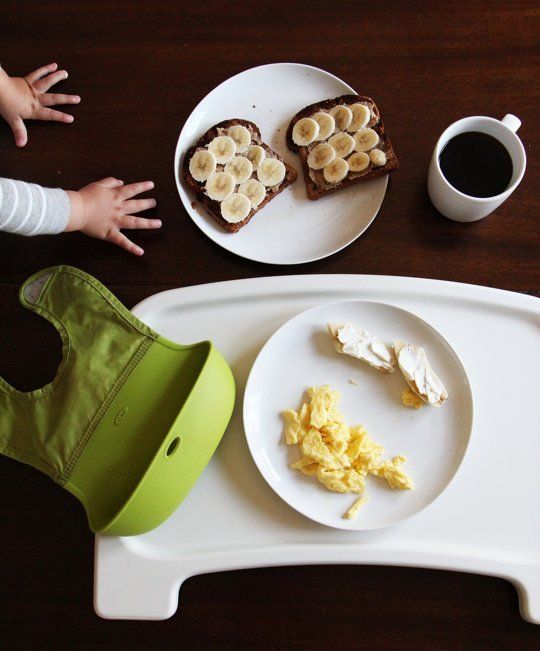 0
0 - Meat puree (cutlet) - 60.0
- Garnish (vegetable, cereal) -100.0
- Fruit juice -100.0
- Kefir with a bun -200.0
- Fruit -100.0
Dinner
- vegetable- (porridge) –200.0
- milk (kefir) –150.0
from 1 year 9 months to two years
Children's food in this age period in this age period in this age period in this age period in this age period it can be liquid, semi-liquid, steamed, and also in the form of pieces (for the development of the child's chewing apparatus). The kid should equally willingly eat any food, no matter in which of the listed types it is served. We recommend the following menu:
Breakfast
- Milk porridge (noodles, vermichel)
- coffee with milk (tea)
- roll with butter (jam, cheese)
9000
SUPPORT
- Kefir fruits
045
